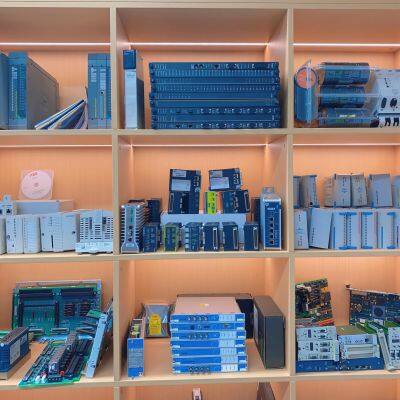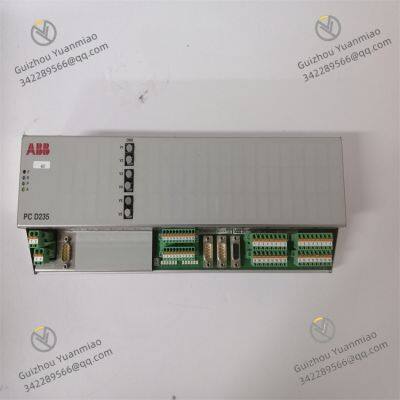Product Description
I. Overview
ABB PVD164A2059 3BHE014340R2059 is an industrial-grade high-precision power drive control module under the Industrial Drives series of the Swiss ABB Group. Its core positioning is to provide stable and accurate power drive as well as control signal conversion functions for medium and high-voltage motors, servo mechanisms, and precision actuators in industries such as metallurgy, electric power, petrochemicals, and intelligent manufacturing. It serves as a key power interface unit between ABB ACS series inverters, DCS (Distributed Control Systems), and on-site execution equipment.
Integrating core functions including high-power signal processing, precise current and voltage regulation, and multiple safety protections, it enables efficient conversion from control signals to power signals, adapting to the drive requirements of different types of medium and high-voltage loads (such as rolling mill motors, fans, water pumps, and precision transmission mechanisms). It effectively addresses issues in industrial scenarios such as large load fluctuations, high drive precision requirements, and difficulty in adapting to complex working conditions. It is suitable for applications like main drive control of rolling mills in metallurgical plants, drive of induced draft fans in power plants, speed regulation of compressors in petrochemical installations, and drive of servo mechanisms in intelligent production lines, ensuring the stability, safety, and efficiency of equipment operation.
This module adopts a compact industrial-grade packaging design (dimensions approximately 300mm×200mm×80mm, subject to installation configuration). The housing is made of high-strength aluminum alloy (with surface anodization treatment), featuring both excellent heat dissipation performance (heat dissipation efficiency 35% higher than traditional plastic housings) and mechanical protection capabilities. It operates within a temperature range of -20℃~70℃, making it adaptable to complex environments such as high temperatures in metallurgical workshops and outdoor control cabinets in the electric power industry. It supports wide-voltage input and multi-type signal interaction, and is compatible with ABB ACS880/ACS6000 series inverters and third-party control systems. Equipped with multiple built-in safety protection mechanisms and a fault diagnosis unit, it has a Mean Time Between Failures (MTBF) of ≥120,000 hours, meeting the "long-cycle and high-reliability" operation requirements of industrial equipment. Meanwhile, it adopts a modular design, allowing flexible configuration according to load power demands to adapt to drive control scenarios of different scales.

II. Technical Parameters
Electrical Parameters
2. Environmental and Reliability Parameters
3. Communication and Control Parameters

III. Functional Features
1. High-Precision Power Drive and Signal Conversion
With high-precision power drive as its core, PVD164A2059 3BHE014340R2059 enables efficient and accurate conversion from control signals to load drive signals:
Wide-Range Power Adaptation
It supports an AC input voltage of 380V-690V AC (50/60Hz) and an output power range of 50kW-200kW, making it adaptable to medium and high-voltage motors and actuators of different power levels. Adopting advanced PWM (Pulse Width Modulation) technology, it has an output frequency adjustment range of 0-500Hz, a voltage regulation accuracy of ±0.5%, and a current regulation accuracy of ±0.3%. For example, in the main drive control of a rolling mill in a metallurgical plant, the module receives speed control signals from the inverter, converts the 380V AC input into power signals with adjustable frequency and voltage to drive the rolling mill motor, and the motor speed control accuracy reaches ±1rpm (rated speed 1500rpm), meeting the rolling precision requirements of the rolling mill.
Multi-Type Control Signal Interaction
It supports the input of multiple types of control signals, including analog signals (4-20mA DC/0-10V DC), digital signals (24V DC dry/wet contacts), and pulse signals (0-10kHz), and can be directly connected to ABB DCS systems, PLCs (Programmable Logic Controllers), or third-party controllers. The analog signal sampling accuracy reaches 16 bits, with a response time ≤100μs, enabling quick capture of changes in control commands. For instance, in the servo drive of an intelligent production line, the module receives 4-20mA position control signals from the PLC, adjusts the output power in real time, and drives the servo motor for precise positioning, with a positioning error ≤0.02mm. The digital signals support 16 input channels and 8 output channels, enabling logical control such as equipment start-stop, fault reset, and status feedback. For example, after receiving an "emergency stop" digital signal, it cuts off the output power within 50ms to ensure equipment safety.
Low Harmonic Distortion Output
It adopts advanced sine wave filtering technology and harmonic suppression algorithms, with an output current Total Harmonic Distortion (THD) of ≤3% (at rated load), which is much lower than the industry standard (≤5%). This can effectively reduce electromagnetic interference to the power grid and surrounding equipment. For example, in the drive of an induced draft fan in a power plant, the low-harmonic current output by the module avoids fluctuations in the power grid voltage, while reducing the heat loss of the fan motor and extending the motor's service life.
2. Multiple Safety Protections and Fault Diagnosis
In view of the characteristics of large load fluctuations and high fault risks in industrial drive scenarios, the module maximizes operational safety through multiple protection and intelligent diagnosis designs:
Comprehensive Electrical Protection
It has built-in multiple electrical protection functions, including overcurrent, overvoltage, undervoltage, overload, overheating, short-circuit, phase loss, and ground fault protection. The operating current of overcurrent protection can be flexibly set according to the rated current of the load (1.1-1.5 times the rated current), with an operating response time ≤10μs, which can quickly cut off the power output to avoid damage to the module and the load. For example, in the drive of a compressor in a petrochemical installation, when the compressor is overloaded due to viscous medium (current reaching 1.4 times the rated value), the module triggers overload protection within 15μs, cuts off the output, and issues an alarm. Overvoltage protection targets input voltage fluctuations (such as sudden rises in power grid voltage); when the input voltage exceeds 750V AC, it automatically limits the output power. Overheating protection uses a built-in temperature sensor to monitor the temperature of the module's core components (such as IGBT chips) in real time; when the temperature exceeds 85℃, it triggers derated operation, and when the temperature exceeds 95℃, it cuts off the output to prevent component burnout.
Intelligent Fault Diagnosis and Feedback
It integrates a high-precision fault diagnosis unit that can real-time monitor the status of the module's internal circuits (such as IGBTs, rectifier bridges, and filter capacitors), input/output electrical parameters, and load operating status, with a diagnosis coverage rate of 98%. Fault information is intuitively fed back through LED indicators (PWR: green for power, RUN: green for operation, ERR: red for fault, ALM: yellow for alarm), and detailed fault codes (such as "E01: Overcurrent Fault", "E05: IGBT Overheating", "E10: Phase Loss Fault") are uploaded to the controller or upper computer via RS485/Profinet communication interfaces. Maintenance personnel can quickly locate problems through the fault codes, reducing troubleshooting time by 60%. For example, when the module detects an output short circuit, it immediately triggers the ERR indicator to light up, uploads the fault code "E03: Output Short Circuit", and records the current and voltage data at the time of the fault to facilitate subsequent fault analysis.
Redundant Backup and Fault-Tolerant Operation
It supports dual-module redundant configuration (master-standby mode); when the master module fails, the standby module automatically switches to operation within 100ms, ensuring uninterrupted load drive. For example, in the main drive system of a rolling mill in a metallurgical plant, the dual-module redundant configuration can avoid rolling mill shutdown caused by drive module faults, ensuring continuous operation of the production line. At the same time, it supports load fault-tolerant control; when a slight load abnormality is detected (such as slight motor stalling), the module automatically adjusts output parameters (such as reducing output frequency and limiting output current) to maintain basic operation and prevent fault escalation.


Basler Electric DECS125-15-B1 Digital Excitation Controller
BENTLY NEVADA 3701/55 ADAPT Condition Monitor
GE L90-W03-HKH-F8L-H6P-L6C-N6C-S6C-U6L-W7G Multilin L90 Protector
ABB PM863K01 3BSE088381R1 AC 800M Processor Unit Controller
ABB NGC8206 Natural Gas Chromatographs
Lam Research 810-068158-014 PCBA CIRCUIT BOARD
GE DS200TCDAH1BJE Mark V Digital I/O Board
ABB 086329-004 End Column Sensor Module
ABB 086370-001 Circuit Board
ABB 086339-501 Digital Input Module
ABB 086348-001 PC Board
ABB 086444-005 Measurement Process Board
 yezi
Hi there! Welcome to my shop. Let me know if you have any questions.
yezi
Hi there! Welcome to my shop. Let me know if you have any questions.




